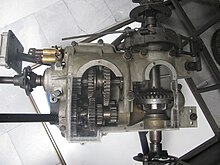Transaxle
This article has multiple issues. Please help improve it or discuss these issues on the talk page. (Learn how and when to remove these template messages)
|

A transaxle is a single mechanical device which combines the functions of an automobile's
versions.Engine and drive at the same end
Transaxles are nearly universal in all automobile configurations that have the engine placed at the same end of the car as the driven wheels: the front-engine/front-wheel-drive; rear-engine/rear-wheel-drive; and mid-engine/rear-wheel-drive arrangements.
Many
The front-wheel-drive Renault 16 had a longitudinal engine and transaxle, with the engine behind the transaxle. The transaxle case was designed to allow the final-drive ring gear to be on either side of the pinion; this allowed the engine-transaxle assembly to be used in the rear-wheel-drive Lotus Europa, which had the engine in front of the transaxle (i.e., mid-engined).
Front-engine, rear-wheel-drive transaxles
Since this placement of the gearbox is unsuitable for a
Notable front-engine, rear-wheel-drive vehicles with a transaxle design include:
- 1898–1910 De Dion Bouton
- 1914–1939 Stutz Bearcat
- 1929–1936 Bugatti Type 46
- 1934–1944 Škoda Popular
- 1950–1958 Lancia Aurelia
- 1951–1956 Pegaso Z-102
- 1957–1970 Lancia Flaminia
- 1959–1963 DAF 600
- 1961–1963 Pontiac Tempest
- 1964–1968 Ferrari 275
- 1963–1968 Ferrari 330
- 1968–1973 Ferrari 365 GTB/4 "Daytona"
- 1972–1984 Alfa Romeo Alfetta
- 1974-1987 Alfa Romeo Alfetta GT/GTV and GTV/GTV6
- 1976–1988 Porsche 924
- 1976–1991 Volvo 300 series
- 1977–1985 Alfa Romeo Giulietta (116)
- 1978–1995 Porsche 928
- 1982–1995 Porsche 944 and Porsche 968
- 1984–1987 Alfa Romeo 90
- 1985–1992 Alfa Romeo 75/Milano
- 1989–1991 Alfa Romeo SZ/RZ
- 1992–2003 Ferrari 456
- 1996–2005 Ferrari 575M
- 1997–2004 Chevrolet Corvette C5
- 1997–1999 Panoz Esperante GTR-1
- 1997–2002 Plymouth Prowler
- 1998–2005 Shelby Series 1
- 2001-2007 Maserati Coupé and Spyder
- 2004–2016 Aston Martin DB9
- 2004 Peugeot 907 Concept
- 2004–2009 Cadillac XLR
- 2004–2013 Chevrolet Corvette C6
- 2004–2011 Ferrari 612 Scaglietti
- 2004–2012 Maserati Quattroporte
- 2005–2017 Aston Martin V8 Vantage
- 2006–2012 Ferrari 599 GTB Fiorano
- 2007–2010 Alfa Romeo 8C Competizione
- 2007–2019 GranCabrio
- 2007- Nissan GT-R
- 2008–2018 California T
- 2009–2012 Lexus LF-A
- 2010–2020 Aston Martin Rapide
- 2010–2013 Mercedes-Benz SLS AMG
- 2012–date Aston Martin Vanquish
- 2017–date Ferrari F12berlinetta
- 2014–2019 Chevrolet Corvette C7
- 2014–date Mercedes-AMG GT
- 2017–date Portofino M
Note: The C5, C6 and C7 Corvettes, produced in the 1997 to 2019 model years, do not feature an integrated transaxle, where the transmission, axle and differential are combined into a single assembly. These years actually featured a rear-mounted transmission, which was a stand-alone unit bolted directly to the differential. While many, including General Motors, refer to this configuration as a transaxle, the first Corvette with an integrated transaxle was produced in the eighth generation Corvette, which was released in the 2020 model year.
Rear-engine, rear-wheel-drive transaxles
Volkswagen and later Porsche made extensive use of transaxles in their rear (and mid) engined vehicles. Over the years, models adopting this configuration have included:
- 1921–1925 Rumpler Tropfenwagen
- 1938–2003 Volkswagen Beetle
- 1940–1945 Volkswagen Kübelwagen (Type 82)
- 1941–1944 Volkswagen Schwimmwagen (Type 166)
- 1947–1961 Renault 4CV
- 1948–1965 Porsche 356
- 1950–1990 Volkswagen Type 2 T1-T3
- 1955–1974 Volkswagen Karmann Ghia
- 1960–1969 Chevrolet Corvair [2]
- 1961–1973 Volkswagen Type 3
- 1963–1976 Hillman Imp
- 1963–present Porsche 911
- 1964–1969 Škoda 1000 MB
- 1965–1969, 1976 Porsche 912
- 1967-1973 Matra 530 (mid-engined)
- 1967-1973 Lamborghini Miura (mid-engined)
- 1968–1974 Volkswagen Type 4
- 1969–1976 Porsche 914 (mid-engined)
- 1969–1980 Škoda 100, Škoda 110 R
- 1971-1978 Maserati Bora
- 1971-1992 De Tomaso Pantera
- 1973-1980 Matra Bagheera (mid-engined)
- 1975–1989 Porsche 930
- 1976–1990
- 1980-1983 Matra Murena (mid-engined)
- 1981–1983 DeLorean
- 1984-1988 Pontiac Fiero (mid-engined)
- 1991-1995/2006-present Cizeta V16T(mid-engined)
- 2013–present Praga R1 (mid-engined)
- 2020–present Chevrolet Corvette C8
Four-wheel-drive
All
The Nissan GT-R and Ferrari FF (and its successors) are unusual in being all-wheel-drive cars with front-engined layouts and rear-mounted transaxles. In the Nissan, one driveshaft sends power to the transaxle (which also contains the 'center' differential) and another driveshaft sends power back along the car to the front wheels. In the Ferrari, the rear transaxle works in a conventional manner, whilst the drive to the front wheels comes from a separate gearbox at the front of the engine.
Other 4WD applications include:
- 1979-2002 Volkswagen Vanagon/Caravelle Syncro Edition - rear-engined, transaxle in the front;
- 1984–1986 Ford RS200 – mid-engined, with the gearbox in the front;
- 1989-2001 Mitsubishi 3000GT - front-engined, gearbox (transmission, front and centre differential) in the front;
- 2007–on Nissan GT-R – front-engined, gearbox in the rear.
- 2011–2016 Ferrari FF
See also
References
- ^ "What is a Transaxle? (With pictures)".
- ^ "GM Heritage: The First Corvair". History.gmheritagecenter.com. Retrieved 2017-05-24.
